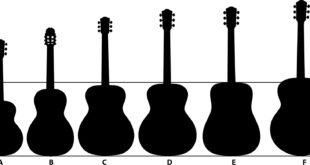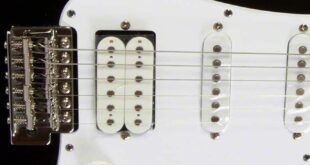Whether you only have one guitar or a slew of them, you need to have a system in place to keep them all within easy reach. If not all of them, at the very least, the one you play regularly. You could put them in a gig bag, but that takes up the same amount of space and adds more steps to the procedure.
It’s crucial to be cautioned about the dangers of leaning guitars against the wall or leaning them awkwardly on a chair during practice sessions. Furthermore, this is just another reason why a guitar stand isn’t worth the money. After all, it won’t cost you an arm and a leg, but it can cost you a (guitar) neck if you don’t buy one.
Most people believe that hanging their guitar in place makes it more vulnerable to damage. Although hangers may appear to be more attractive (and are usually less expensive), a guitar wall mount may cause harm to your instrument’s neck, as well as the wall. As a result, most people prefer to use a stand, especially for their pricey guitars. Here, you tuck the guitar away in a corner on a stand.
Even if the guitar looks fine on a guitar hanger on the wall, you might not be able to determine a suitable location for it. Furthermore, hanging your guitar on the wall and removing it is impractical and cumbersome, especially if you play a lot and want to reach the instrument most of the time. Stands, on the other hand, are more practical and portable because they stay on the floor.
However, practically every guitar store in the world hangs their inventory on hangers, so we don’t believe it harms the neck. Many people think that wall hangers are beneficial because the weight of the guitar body maintains the neck straight, which aids in precise intonation.
There are essentially four types of guitar stands to select based on your requirements:
- A-Frame Guitar Stands
- Guitar Tripod Stands
- Multi-Guitar Racks
- Guitar Wall Mounts and Hangers
Durability and stability are the most crucial features to look for in a guitar stand. A decent stand should have enough foam cushioning on the meeting places where it comes into contact with the instrument. This will protect the guitar’s finish against scratches, which will detract from its appearance and resale value.
Table of Contents
Top picks: The best guitar stands and holders:
If you plan to transport the stand for rehearsals and performances, portability is an important consideration. The stand should be stable, light, and foldable to the point where you can store it in the trunk of your car. Guitar stands serve as a great way to store and display your guitar when not in use.
This article covers the best of the best guitar stands and holders for 2021. We’ll make sure that each guitar stand offers three solutions: cheap, mid-market, and premium. Let’s get started now that we’ve got our work cut out for us.
Pros:
- Has a beautiful wooden frame
- Has adjustable height and mechanism
- Usage of top-quality, genuine leather as contact surface cushioning
- Leather on the stand’s edges
Cons:
- More on an expensive side
This stand has unique foam that is only available from this company. You may find this novel cushioning on both the lower contact surfaces, at the base of the stand and the fretboard yokes at the top horizontal bar. Long arms on the yokes on this model prevent the neck from being dislocated. This compensates for the lack of a safety latch. You can also change where they are in the bar. The rack at first can appear to be huge. It does, however, save more room than two multi-guitar stands and is simple to put together.
Pros:
- It is secure, stable, portable, and offers great value for your money.
- Simple to put together
- Novel cushioning
- Long arms on the yokes prevent the neck from being dislocated
Cons:
- Occupies a lot of space
The frame’s quality is something to be admired. The bars are thick, providing adequate support for various guitars. This guitar stand features short bars that function as guitar divisions. While individual yokes would have been preferable, it is still a good design that will limit the odds of your guitars colliding.
Your instruments will be well protected through the velveteen rubber cushioning on both the upper and lower bars. The one thing we’re iffy about is whether the material will be safe for guitars with nitro finishes.
Pros:
- A worthy solution for organizing and storing guitars
- It has a solid frame
- Instruments will be well protected through the velveteen rubber cushioning
Cons:
- It may not be safe for guitars with nitro finishes
One feature of this String Swing CC01K Guitar Wall Hanger CH that distinguishes it from the rest includes a cherry wood mounting plate. The deep Cradle design of the CC01K guitar hanger prevents the instrument from being inappropriately put into the bracket. However, the guitar must be lifted approximately 2 inches to be removed.
The non-symmetrical bass, electric, and acoustic guitar headstocks are properly held and hang straight. This String Swing CC01K Guitar Wall Hanger CH is suited for neck widths up to 47,5 mm (1,88″).
Pros:
- It’s equally at home in the studio as it is in the backstage area of a musical hall.
- Compatible for all Nitrocellulose finishes
- Includes a cherry wood mounting plate
Cons:
- Needs to be lifted to be positioned
The X-frame structure also adds to the stability of the guitar stand. In addition, EVA protective cotton is meant to prevent scratching of the guitar at the point where it comes into touch with it. Donner DS-3X can exactly complement your guitar, whether it’s an electric or acoustic guitar. It is suitable for any guitar with a variety of resonance boxes.
Pros:
- Beautiful wooden frame
- Doesn’t occupy a lot of space due to its size
- Protective cotton is meant to prevent scratching of the guitar
Cons:
- Accident-prone
What to look for when buying a guitar stand:
Have you reached your decision yet? Knowing what sort of guitar stand to buy is simply one aspect of the decision-making process. What needs to be assessed even more thoroughly are the variables that every consumer must consider while purchasing these music assistants.
Material:
There are a few possibilities available here. Wood and steel are the most prevalent materials. Plastic is used in some brands as well. The sort of finish on your guitar will influence your decision. Guitars with nitrocellulose finishes, for example, look great on wooden guitar platforms. It would be best if you didn’t choose a stand constructed of steel or plastic since these elements can damage your instrument’s finish. However, these stands can be used if you plan to pay special attention to placing your instrument on the stand. But remember: the guitar stand’s visible (unpadded) exteriors should not come into touch with your instrument.
Guitar protection:
Many guitar stands include at smallest one cradle to support the guitar’s body. Certain products include a neck cradle as well. Even so, there are solutions that allow you to hang your guitar from a top-mounted holder. There is continuously a portion of the guitar stand that will make contact with the guitars in these designs. These areas should always be well cushioned. The majority of goods come with foam stuffing. Others offer rubber. We’ve also seen some companies use leather to hide the connection points on their guitar supports. It is critical to inspect the cushioning quality, regardless of the material used. It should be deep enough to grasp any impact pressures that aren’t essential. To assist in maintaining the integrity of your guitar, the guitar stand’s surface should be smooth and non-marring.
Portability:
A guitar stand’s portability is determined by its size, weight, and folding or collapsible construction. Bringing cumbersome stands to your gigs can be a trial, while stands that are extra-lightweight might not be as enduring as you would like. Consider how these variables combine to form a portable guitar stand that is both stable and secure.
Adjustability:
If you’re pressing about your guitar playing, you’ll want to invest in a stand that you can adjust. This is ideal for people who are planning on updating their guitar shortly. You can store many types and models of guitars on an adjustable guitar stand. The electric guitar is a good illustration. Manufacturers frequently develop their trademark style. Because acoustic guitars make music differently than electric guitars, this isn’t always the situation.
Fretboard latch availability:
The lack of a method to secure the guitar to the stand is one concern that never fails to be brought up about guitar platforms. This is particularly true in the case of A-frame stands. The guitar is held in place by its weight and the cradle at the bottom of the stand legs. Unfortunately, one swipe at it is all it takes to put your instrument out of commission. This is why folks constantly tell their friends to solicit a fretboard clasp on a guitar stand. The latch is regarded as a guitar stand’s added security feature. It’s similar to having a strap that prevents the neck or fretboard from tilting to one side and throwing the stand’s balance off. This is one approach to keeping your guitar in good condition. Unfortunately, this feature may not be available on all guitar stands.
Ease of assembly:
The bulk of guitar stands are made up of multiple parts that you must put together yourself. Manufacturers have certainly gone to considerable measures to make disassembly and assembly as simple as humanly possible. However, some products will continue to be badly constructed. Placing the various components together is similar to putting together a jigsaw puzzle with pieces from various boxes. There’s also the possibility of compromising the guitar stand’s general stability. Repeated assembly and disassembly can cause connections to loosen. There may be loose threads on the stand. The convenience of installation and disassembly should not occur at the price of the guitar stand’s quality.
Overall build quality:
Let’s just discuss the stability of a guitar stand. This reflects the product’s overall construction quality. Investing in a high-quality guitar stand should alleviate any quality issues. Several of these companies ensure that the products they put on the exchange are of the highest quality.
These are the guitar stands that will continue to function even after you have passed away. Not everyone wants a high-end guitar stand. That is why we should carefully inspect the build quality of the guitar stand we intend to purchase. This is also why we recommend that you purchase a guitar platform in person. This will allow you to examine the stand’s many joints, surfaces, finishes, and features.
It would be difficult to undertake a thorough evaluation of the guitar stand before purchase if you made all of your purchases online. Customer reviews might give you information on the product’s construction.
They may also provide insight into how great the product will withstand the stresses of guitar storage. Pay heed to what other guitar stand purchasers have to say. A guitar platform that has served you well for some years is always an excellent investment. A stock that disappoints after just a few months should be a warning sign.
Price:
When it comes to purchasing anything, most people consider pricing one of the most significant factors. When choosing a guitar stand, the situation is similar. This item can be purchased for a variety of costs. You can acquire a cheap guitar stand for around $15 or even less. The most expensive ones usually cost more than $115. Guitar stands with innovative technologies or rare materials that are one-of-a-kind might cost upwards of $200.
Frequently asked questions:
Is the guitar stand right for me?
People prefer a guitar hanger over a guitar stand because of the few advantages it provides. Of course, that does not mean stands are not worth buying. A guitar stand has its own advantages- it all depends on preference.
What to look for in a guitar stand?
Let’s start with one of the most common worries that guitarists have about guitar stands. The main concern is guitar safety. You might quickly damage your musical instrument if you choose the wrong guitar stand. A stand can topple over, collapse to the floor, and destroy or damage the instrument.
Even with a fairly robust stand, there is still the possibility of it tipping over. You may have children or even pets in your home. When children play and run, they may swipe at the guitar, causing the stand to fall. Pets, such as cats and dogs, are in the same boat. There are also cases of clumsiness on the part of the individual.
You could be so preoccupied with what you’re reading or who you’re talking to on your phone that you don’t notice the guitar stand blocking your way. The next thing you know, you’re hearing a huge crash and seeing pieces of your guitar flying around.
We’re not suggesting that hanging a guitar is a good idea. Guitar hangers that aren’t correctly placed are equally dangerous as a shaky and poorly designed guitar stand. The aim is to acquire the greatest possible stand for your guitar. Another consideration when purchasing a guitar stand is the amount of space available. Some stands take up a lot of room on the floor. If you live in bigger homes, this shouldn’t be an issue. Guitarists who live in crowded dorm rooms or compact apartments may not have this luxury. It’s a good thing there are space-saving guitar stands.
If you don’t want to hang your instrument on the wall for fear of falling, we recommend using a guitar stand. If you have enough space in your home and don’t have any young children or disobedient pets, a guitar stand is also a good choice.
Final verdict:
We’re sure you’ll agree that your guitar looks terrible when it’s lying on the couch or leaning against a wall in a dark corner. Using a guitar stand improves the appearance and protects the instrument. In this article, you will find a large variety of Guitar Stands and Wall Hangers.
If you don’t want to hang your instrument on the wall for fear of falling, we recommend using a guitar stand. A guitar stand is also a good choice if you have enough space in your home and don’t have young children. A guitar stand is a terrific way to keep your instrument safe and secure in the comfort of your man cave. It’s more portable than a guitar wall hanger, so you can take it with you to gigs, outings, and other out-of-home activities.
While there are certain matters concerning guitar safety, you may mitigate these worries by purchasing the best guitar stand you can afford. Any of the guitar stands we tested and recommended in this post are excellent choices. It’s simply a matter of deciding which one is best for you based on your requirements and personal preferences.
 The Occasional Orchestra Learn About Everything Music!
The Occasional Orchestra Learn About Everything Music!








